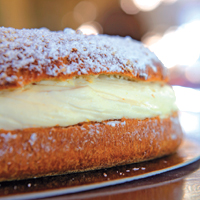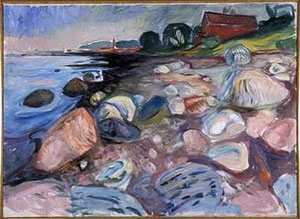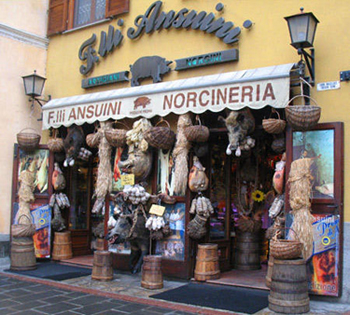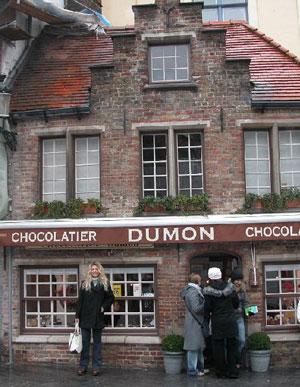 When I told friends I was going to spend four weeks in St. Tropez last summer, more than one of my foodie friends told me I must try the Tarte Tropezienne—which was described to me as a giant brioche filled to the heavens with a creamy vanilla custard. This sounded like a dream come true. As I child I loved pudding—homemade butterscotch pudding, or bread pudding, or crème brulee, were the best—but mostly we ate packaged pudding, the Jell-O Brand. I liked vanilla and my brother, ten months older, liked chocolate, and my father told us that as toddlers we would sit facing each other in twin highchairs and smear our respective puddings all over our faces, smiling in ecstasy.
When I told friends I was going to spend four weeks in St. Tropez last summer, more than one of my foodie friends told me I must try the Tarte Tropezienne—which was described to me as a giant brioche filled to the heavens with a creamy vanilla custard. This sounded like a dream come true. As I child I loved pudding—homemade butterscotch pudding, or bread pudding, or crème brulee, were the best—but mostly we ate packaged pudding, the Jell-O Brand. I liked vanilla and my brother, ten months older, liked chocolate, and my father told us that as toddlers we would sit facing each other in twin highchairs and smear our respective puddings all over our faces, smiling in ecstasy.
So naturally, finding and sampling this so-called Tarte Tropezienne went to the top of my “list of things to do” while I visited St. Tropez. That’s what one does when one travels to France—you get obsessed with pastries. And wine. And bread. And olives. And cheese. Plus, we New Yorkers tend to become obsessed with finding “the best” (primarily so that we can go back and tell our friends at dinner parties that we found “the best” goat cheese or the best rosemary-and-olive fogasse or the best early-season figs.
Travel
Travel
Munch and Warhol
 Munch's summer house was not far from my family's summer home, in Åsgårdstrand. He spent every summer there between 1889 and 1905, fell in love with the pretty town and with a married woman, Milly Thaulow (Mrs Heiberg).
Munch's summer house was not far from my family's summer home, in Åsgårdstrand. He spent every summer there between 1889 and 1905, fell in love with the pretty town and with a married woman, Milly Thaulow (Mrs Heiberg).
The Shore of Love (Kjaerlighhetens Strand) is the 2010 summer exhibition at Haugar museum in Tonsberg. It's a rare treat and one of the biggest Munch exhibits ever held outside of Oslo or Bergen. The images are familiar to Munch fans – the lovers, the girls on the beach, the big Norwegian moon spreading light across the water.
Andy Warhol was a great fan of Munch. He first saw the work at a gallery in New York in 1982. Both men lost a parent at a very young age, and both, it seems were obsessed with death. His paintings and silkscreens are inspired by Munch's The Scream, Madonna and Self-portrait with Skeleton Arm.
A Treasure in Barcelona
 “This one, honey, this one looks good.” I said excitedly to Shannon on our first night in Barcelona. We were standing in front of a small, lofted restaurant with windowed walls, wood furniture and an elaborate artistic white chandelier.
“This one, honey, this one looks good.” I said excitedly to Shannon on our first night in Barcelona. We were standing in front of a small, lofted restaurant with windowed walls, wood furniture and an elaborate artistic white chandelier.
We had been walking through the city for hours and wound up here in Barceloneta, a triangular neighborhood which jettisons out from Barcelona proper and is famous for gorgeous beaches and trendy restaurants. It was a clear spring evening following a warm eventful day and we were starving and exhausted.
I have a romantic notion about food while on vacation. I believe that the most incredible meals will be found in restaurants on curvy, dimly lit side streets, run by generations of ego-free chefs who just want to cook incredible food for their family and whoever might be brave or lost enough to stumble down their road. This theory gets me into a lot of trouble.
We had walked down many a crooked street that day to no avail. The restaurant we stood in front of that night, Lonja de Tapas, was clearly not the place in my fantasy (a lot of money had been put into the décor and it was very crowded), but low blood sugar was fueling my optimism and I bounded through the door.
Alla Norcina
 Norcia is a secluded, walled city in the mountainous region of the Valnerina in southeastern Umbria. Its history dates back to the fifth century before Christ. St. Benedict and his twin sister were born there in the year 480. Other than that, Norcia is famous for its pork products and its black truffles. It’s the pork capital of Italy – so much so that the shop of a pork butcher anywhere in Italy is called a norcineria.
Norcia is a secluded, walled city in the mountainous region of the Valnerina in southeastern Umbria. Its history dates back to the fifth century before Christ. St. Benedict and his twin sister were born there in the year 480. Other than that, Norcia is famous for its pork products and its black truffles. It’s the pork capital of Italy – so much so that the shop of a pork butcher anywhere in Italy is called a norcineria.
There are two very different pasta dishes that go by the name alla norcina. Version one — often made with fresh pasta like fettucine or the local Umbrian pasta, strangozzi – is simply pasta with fresh truffle grated over the top. Of course, it’s not that simple. Actually you chop a clove of garlic together with a couple of anchovies, put them into olive oil in your pan. Heat and stir into a paste. Toss the cooked pasta into the pan, stir and then grate the truffle over the top. That’s one version. Alla Norcina version two is a whole other kettle of macaroni. It’s generally served over dried pasta – usually penne or rigatoni. It features pork sausage and it’s one of the most satisfying recipes in the repertorio – especially in the winter when you want to warm yourself from the inside. So simply, it’s pasta with crumbled sausage, cream and truffles. But once again, it’s not that simple.
Old World Chocolatiers in Brugge
 The temptation of chocolate draws Chocoholics and chocolate connoisseurs to Brugge, Belgium in droves. Decadent, rich chocolate
shops are beyond prevalent in this well-preserved Gothic city (there are over 40). A turn at every cobblestone corner will be yet another chocolate shop discovery. Belgium is second to none in the chocolate department. If you think Swiss chocolate is supreme, then try Belgian,
and your mind will be forever changed. Here are just a few suggestions to indulge your chocolate cravings.
The temptation of chocolate draws Chocoholics and chocolate connoisseurs to Brugge, Belgium in droves. Decadent, rich chocolate
shops are beyond prevalent in this well-preserved Gothic city (there are over 40). A turn at every cobblestone corner will be yet another chocolate shop discovery. Belgium is second to none in the chocolate department. If you think Swiss chocolate is supreme, then try Belgian,
and your mind will be forever changed. Here are just a few suggestions to indulge your chocolate cravings.
Dumon is a well-known family owned shop. Stefaan Dumon creates exquisite chocolates daily using fresh ingredients sans additives and preservatives. (The shelf life is six weeks.) The staff will go into great detail describing their award winning, decadent, exploding-with-flavor, creamy chocolates. It's customary to find a small crowd gathered around the chocolate display case.
To indulge in one-of-a-kind concoctions, head over to The Chocolate Line near Market Square. Eighty unique varieties, such as a Buddha-shaped ginger chocolate and a white elephant saffron curry will tempt your taste buds.
More Articles ...
Welcome to the new One for the Table ...
Our Home Page will be different each time you arrive.
We're sure you'll find something to pique your interest...


